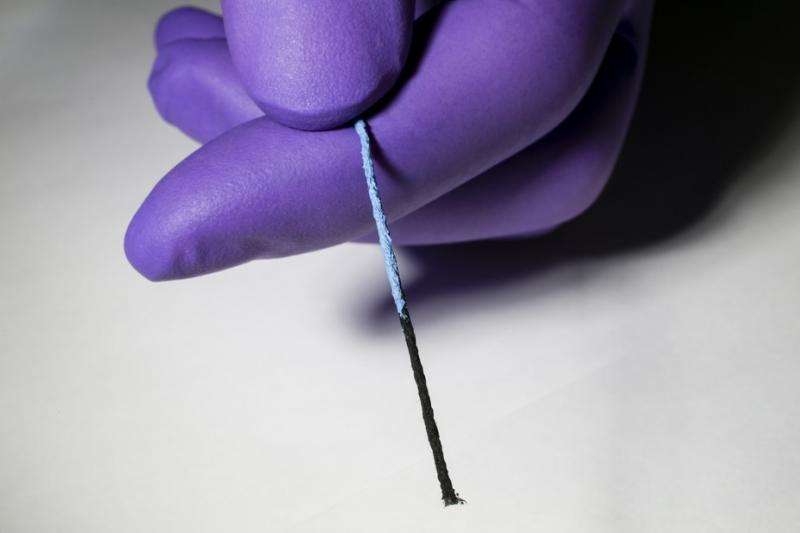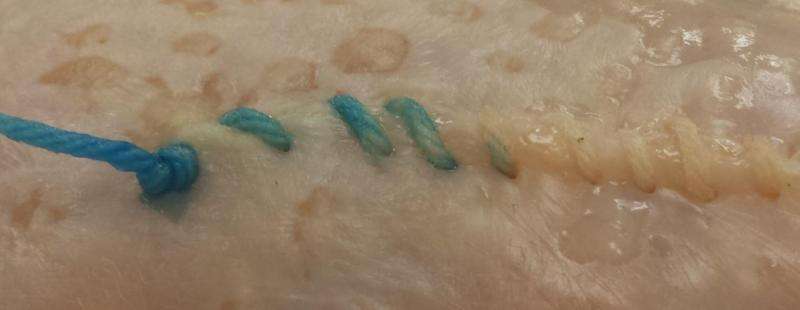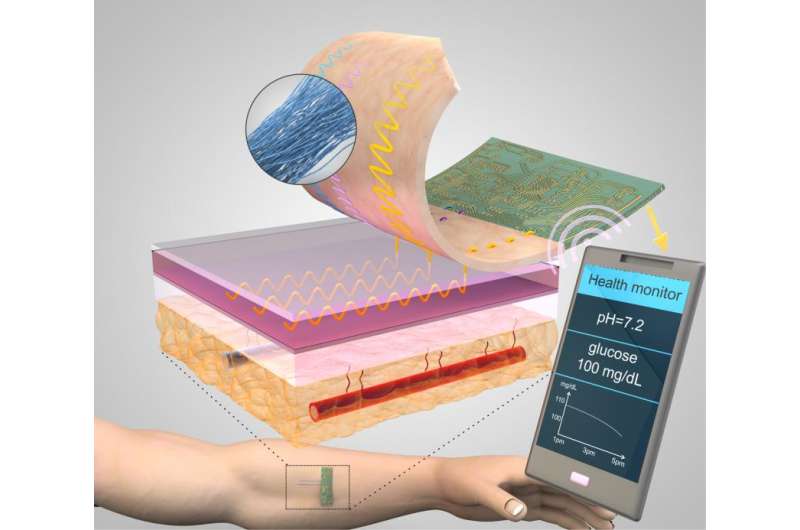The next frontier in medical sensing—threads coated in nanomaterials

Doctors have various ways to assess your health. For example, they measure your heart rate and blood pressure to indirectly assess your heart function, or straightforwardly test a blood sample for iron content to diagnose anemia. But there are plenty of situations in which that sort of monitoring just isn't possible.
To test the health of muscle and bone in contact with a hip replacement, for example, requires a complicated – and expensive – procedure. And if problems are found, it's often too late to truly fix them. The same is true when dealing with deep wounds or internal incisions from surgery.
In my engineering lab at Tufts University, we asked ourselves whether we could make sensors that could be seamlessly embedded in body tissue or organs – and yet could communicate to monitors outside the body in real time. The first concern, of course, would be to make sure that the materials wouldn't cause infection or an immune response from the body. The sensors would also need to match the mechanical properties of the body part they would be embedded in: soft for organs and stretchable for muscle. And, ideally, they would be relatively inexpensive to make in large quantities.
Our search for materials we might use led us to a surprising candidate – threads, just like what our clothes are made of. Thread has many advantages. It is abundant, easy to make and very inexpensive. Threads can be made flexible and stretchable – and even from materials that aren't rejected by the body. In addition, doctors are very comfortable working with threads: They routinely use sutures to stitch up open wounds. What if we could embed sensor functions into threads?
Finding the right sensor
Today's medical sensors are typically rigid and flat – which limits them to monitoring surfaces such as the scalp or skin. But most organs and tissues are three-dimensional heterogeneous multilayered biological structures. To monitor them, we need something much more like a thread.

Nanomaterials can be organic or inorganic, inert or bioactive, and can be designed with physical and chemical properties that are useful for medical sensing. For example, carbon nanotubes are amazingly versatile – their electrical conductivity can be customized, which has led to them being the basis of the next generation of sensors and electronic transistors. They can even detect single molecules of DNA and proteins. The organic nanomaterial polyaniline has a similarly broad range of applications, notably its conductivity depends on the strength of the acid or base it is in contact with.
Making the materials
To make sensing threads, we start with cotton and other conventional threads, dip them in liquids containing different nanomaterials, and rapidly dry them. Depending on the properties of the nanomaterial we use, these can monitor mechanical or chemical activity.
For example, coating stretchable rubber fiber with carbon nanotubes and silicone can make threads that can sense and measure physical strain. As they stretch, the threads' electrical properties change in ways we can monitor externally. This can be used to monitor wound healing or muscle strain experienced due to artificial implants. After an implant, abnormal strain could be a sign of slow healing, or even improper placement of the device. Threads monitoring strain levels can send a message to both patient and doctor so that treatment can be modified appropriately.
Monitoring the electricity flow between one cotton thread coated with carbon nanotubes and polyaniline nanofibers, and another coated with silver and silver chloride, allows us to measure acidity, which can be a sign of infection.
To help people who need to monitor their blood sugar levels, we can coat a thread with glucose oxidase, which reacts with glucose to generate an electrical signal indicating how much sugar is in the patient's blood. Similarly, coating conductive threads with other nanomaterials sensitive to specific elements or chemicals can help doctors measure potassium and sodium levels or other metabolic markers in your blood.

Multiple uses
Beyond sensing abilities, many thread materials, such as cotton, have another useful property: wicking. They can move liquid along their length via capillary action without needing a pump, the way melted wax flows up a candlewick to feed the flame.
We used cotton threads to transport interstitial fluid, which fills in the gaps between cells, from the places it normally exists toward sensing threads located elsewhere. The sensing threads send their electronic signals to an external device housed in a flexible patch, along with a button battery and a small antenna. There, the signals are amplified, digitized and transmitted wirelessly to a smartphone or any Wi-Fi connected device.
These transport-sensing measuring-transmission systems are so small that they can be powered with a tiny battery sitting on top of the skin or could get energy from glucose in the patient's blood. That could allow doctors to keep a continuous eye on patients' health remotely and unobtrusively.
This type of integrated, wireless monitoring has several advantages over current systems. First, the patient can move around freely, rather than being confined to a hospital bed. In addition, real-time data-gathering provides much more accurate information than periodic testing at a hospital or doctor's office. And it reduces the cost of health care by moving treatment, monitoring and diagnosis out of the hospital.
So far our testing of nano-infused threads has been in sterile lab environments in rodents. The next step is to perform more tests in animals, particularly to monitor how well the threads do in living tissue over long periods of time. Then we'd move toward testing in humans.
Now that we've begun exploring the possibilities of threads, potential uses seem to be everywhere. Diabetic patients can have trouble with wounds resisting healing, which can lead to infection, and even amputation. A few choice stitches using sensing threads could let doctors detect these problems at extremely early stages – much sooner than we can today – and take action to prevent them from worsening. Sensing threads can even be woven into bandages, wound dressings or hospital bed sheets to monitor patients' progress, and raise alarms before problems get out of control.
Source: The Conversation
This story is published courtesy of The Conversation (under Creative Commons-Attribution/No derivatives).![]()




















